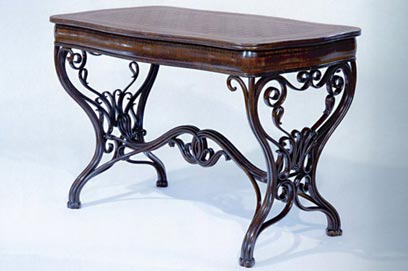When Michael Thonet (Boppard am Rhein 1796 - Vienna 1871), around 1830, he invented the serial technique of steam bending of beech wood, so far only small-scale, gave impetus to a new style of working of this material and it was unanimously recognized as the first industrial designer.
 |
The artistic adventure of the man and the artistic works that are now named after him in the middle of a major exhibition held at the Castello Sforzesco in Milan, between March 11 and April 24, 2005, entitled Thonet: the between design and creation of Biedermeier Vienna Secession. The exhibition, curated by John and Clare Renzi, produced by Silvana Editoriale and sponsored by the City of Vienna, by the Consulate of Austria and the Austrian Cultural Forum, be fully documented in "the universe Thonet", presenting more than 130 furniture products by the teacher and the Gebrüder Thonet Vienna, as well as many catalogs and advertising material.
 |
After a period of apprenticeship, Michael Thonet began in 1819 to direct a laboratory specializing in decorative elements intended to furniture made by other manufacturers and made by bending strips of wood glue and immersed in water and then pressed. To solve the problems caused by the glue of the time, very unstable, Thonet tried to remove them and to use in processing only seasoned wood rods that put in an environment saturated with water vapor and bent when they were wet, giving them the desired shape. This form was maintained then introducing them in special dryers that eliminate the water.
 |
After specialized between 1830 and 1840, production of bentwood furniture, Gebrüder Thonet in the late nineteenth century, was able to make four thousand pieces a day thanks to a workforce of six thousand employees. In 1841 the minister of the Emperor of Austria Metternich, after seeing an exhibition of furniture by Thonet, invited him to Vienna where he became a carpenter court official. The commercial success came, however, with the decisive participation of Thonet International Exposition of 1851, where the extraordinary pieces presented for the first time they talk about industrial design.
 |
The ongoing experiments to the curvature of the wood and the success of models from first with the rich nineteenth-century and then took the square shapes of the Viennese Secession and those with rational tubular metal furniture, are detailed in the exposition being held in Milan. Chairs, tables, sofas, beds, planters, gate scores, racks, desks, tennis rackets, gymnastic rings, children's furniture and rocking chairs for dolls are displayed at each stage of production by Thonet and its many competitors active after 1869, in what represents the first commercial war of modern industry.
 |
In the wake of the success of the company Thonet, in fact, the patent expired in 1869 of steam bending wood, many other companies sprang up and began to specialize in furniture-like bill. Among the most important, the Mundus, the Fischel, the Arx, the Teschen, the Eissler, the Jacob und Joseph Kohn, who attended especially the relationship with the designers and the Paris exhibition in 1900 presented a repertoire of many reasons Art Nouveau. The competition between the Thonet and Kohn increased and induced the first to collaborate with the most famous names in design time. The new furniture they began to be signed by Hoffman and Wagner, who also worked for Kohn, and Joseph Urban, Marcel Kammerer and Joseph Bauer.
 |
The ongoing experiments to the curvature of the wood and the success of models from first with the rich nineteenth-century and then took the square shapes of the Viennese Secession and those with rational tubular metal furniture, are detailed in the exposition being held in Milan. Chairs, tables, sofas, beds, planters, gate scores, racks, desks, tennis rackets, gymnastic rings, children's furniture and rocking chairs for dolls are displayed at each stage of production by Thonet and its many competitors active after 1869, in what represents the first commercial war of modern industry.
Through the different sections of the exhibition, visitors can follow the evolution of the image and communication strategies of the first bentwood furniture with advertisements in newspapers from Austria and Germany, then through the valuable commercial catalogs spread across Europe and the world. Next to the material published by Thonet you look at the pictures of ordinary people, children, soldiers or lovers on swings and bentwood chairs, insight into period dress that evokes places, habits and gestures of the late nineteenth century Europe. The last section of the exhibition covers finally an object of curiosity, what Thonet and the cinema, or the spread of mobile curved in Italian cinema and foreign players of international fame in films still image of known or forgotten.





